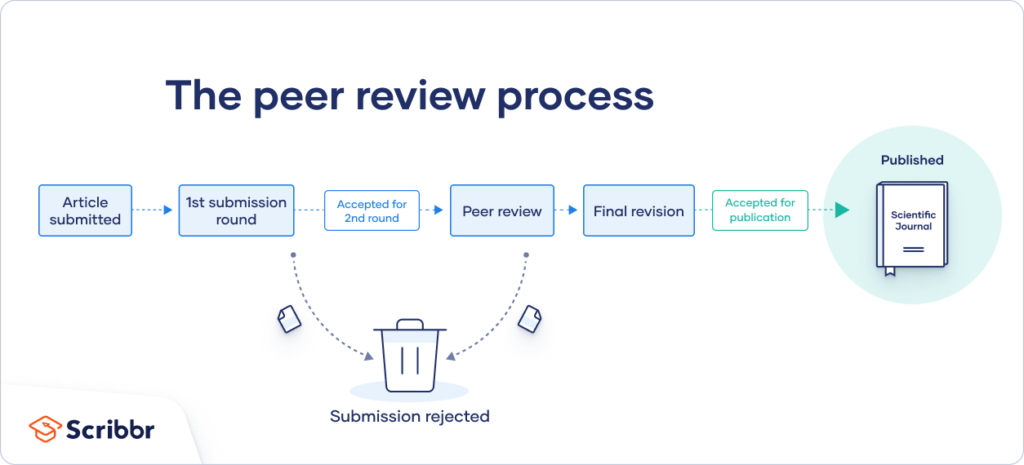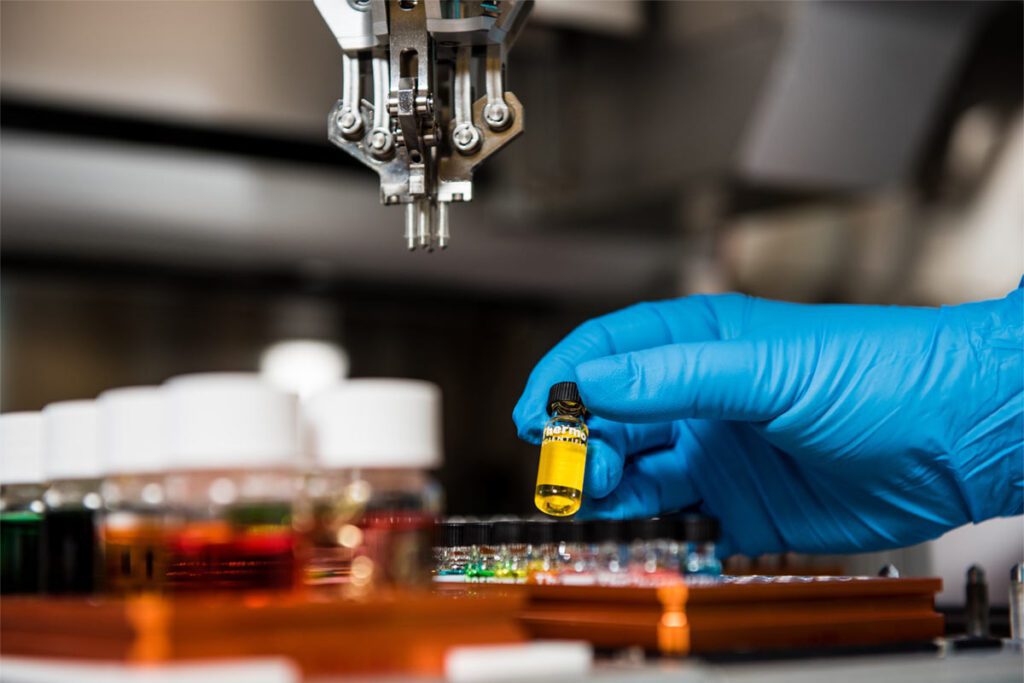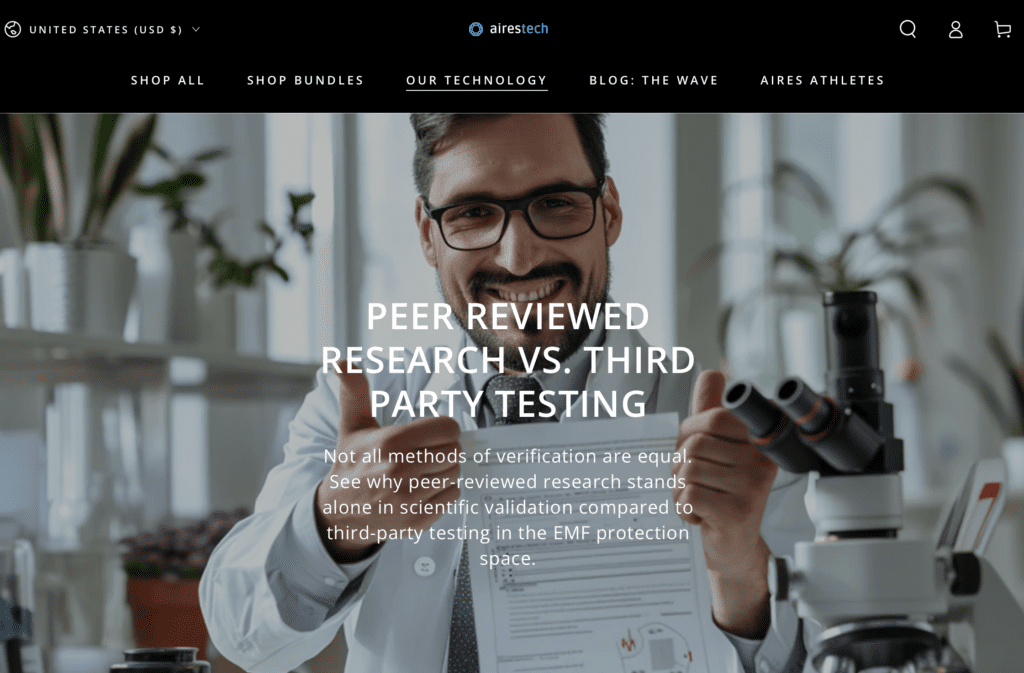Table of Contents
- Peer-Reviewed Research
- Third-Party Testing
- Peer-Reviewed Vs. Third-Party Testing
- Why This Matters in the Case of EMF Protection Solutions
- Case Studies: Evaluating EMF Protection Products
- Peer-Reviewed Studies Validating the Effectiveness of Aires Tech’s Lifetune
- Closing Thoughts on Navigating the EMF Protection Landscape
The presence of electromagnetic fields (EMFs) has become a somewhat unavoidable factor of life in the modern world. These fields are emitted from all of our technological devices; cell phones, smartwatches, and Airpods all create them and in turn, generate electromagnetic radiation (EMR). EMR has been linked to several concerning health conditions and the concerns are only growing as we integrate more of these electronic technologies into our lives.
The New Frontier of EMF Protection


In response to the growing health concerns, a new field of EMF protection products has emerged. While all of these new companies and their products have undoubtedly been created with good intentions, there are some issues around the legitimacy of these products. As consumers navigate deeper into this new industry in hopes of protecting themselves, it becomes increasingly important for them to develop an understanding of the research, or lack thereof, being done on these products.
The two predominant methods for evaluating the efficacy of such products are peer-reviewed research and third-party testing. While both may sound reliable and are often used interchangeably, they are actually very different things – sort of like the difference between free-range and pasture-raised eggs.
In this blog, we will explore the differences between these two methods of validation and what the implications are for EMF protection solutions so that you can be as informed as possible when making decisions to protect your health and that of your loved ones.
Peer-Reviewed Research
Peer-reviewed research forms the backbone of modern scientific inquiry. This process essentially ensures that scholarly work undergoes a rigorous evaluation process before reaching the public domain. The term “peer-reviewed” refers to the scrutiny brought by experts in the same field as the original researchers, commonly referred to as peers or referees. This meticulous examination ensures that the study is methodologically sound, logically structured, and adheres to ethical standards.
Rigorous Review Process by Experts in the Field
The peer-review process typically involves multiple stages. After a researcher submits their work to a reputable journal, an editorial team assesses its suitability for review. If accepted, the manuscript is sent to independent experts in the field who critically assess the study’s design, methodology, statistical analyses, and conclusions. This thorough examination aims to identify potential flaws, biases, or oversights, contributing to a very robust and reliable body of knowledge.


The hallmark of peer-reviewed research is its ability to produce highly credible and reliable findings. By subjecting studies to the scrutiny of knowledgeable peers, the scientific community aims to ensure the accuracy and validity of research outcomes. This process also helps filter out unsubstantiated claims and maintains the integrity of academic literature, continuously cultivating an increasingly solid foundation upon which further research and practical applications can be developed.
Examples of Well-Known Peer-Reviewed Journals in EMF Research
In the world of EMF research, there are a few journals that adhere to rigorous peer-review standards. Examples include the “Journal of Electromagnetic Waves and Applications,” “Bioelectromagnetics,” and “Electromagnetic Biology and Medicine.”
Publications in these journals all undergo the above-mentioned meticulous evaluation, contributing to the growing body of knowledge surrounding the effects of electromagnetic fields on biological systems (AKA people).
Third-Party Testing
While peer-reviewed research emphasizes academic scrutiny, third-party testing uses a different approach to independent evaluation conducted by external entities. Third-party testing involves hiring external organizations or laboratories, separate from the product manufacturer, to assess the product’s performance, safety, and compliance with specified standards. This method aims to introduce unbiased and impartial results and opinions that are free from potential conflicts of interest.


Independence and Unbiased Evaluation
The main strength of third-party testing lies in its independence. External testing organizations operate autonomously from product developers, reducing the likelihood of biased outcomes. This separation ensures that the evaluation is conducted without external influence, providing consumers with a more objective assessment of a product’s claims.
Importance of Using Reputable Third-Party Laboratories
Not all third-party testing is created equal though.
To get meaningful insights into the efficacy of a product or solution, it is absolutely crucial to engage with reputable testing laboratories that are known for their expertise, transparency, and adherence to industry standards. Reliable third-party organizations are those that follow established protocols, employ certified experts, and maintain a commitment to impartiality, reinforcing the credibility of their evaluations.
As you may have guessed, this is where some issues can come up. If a third-party entity is used that is not reputable or upholding certain industry standards, the evaluation may be skewed in a more positive or negative light, or just simply be less accurate.


Peer-Reviewed Vs. Third-Party Testing
Both peer-reviewed research and third-party testing are useful, but the distinct advantages of peer-reviewed research are evident in the rigor it demands. The peer-review process and its meticulous scrutiny from experts within the academic community stand as the gold standard for ensuring the credibility and reliability of research findings.
In comparison, third-party testing is a paid service conducted by independent laboratories where a given company pays for the tester to replicate a specific scenario to show effect. Peer-reviewed studies have an intrinsic motivation for scientifically correct results seeing that institutions and scientists’ names are attached to them, while third-party labs do not have the same level of accountability requirements.
When comparing peer-reviewed research and third-party testing, we can see that the two terms should not be used interchangeably as they often are for marketing purposes since, well, most consumers simply do not know the difference. This marketing tactic of using technical terms to appear more effective or healthy is unfortunately a fairly common move made in business; seen in the comparison we made earlier between pasture-raised and free-range eggs; companies will often upcharge for free-range eggs in an attempt to seem more like pasture-raised which is a much higher standard.
Third-party testing can be great in a well-established field or industry, but the peer-reviewed approach inherently holds a different level of validation which is of huge importance in the realm of EMF protection, where comprehensive and detailed assessments are essential for establishing the efficacy and trustworthiness of products in a relatively under-researched field.
Why This Matters in the Case of EMF Protection Solutions
Understanding the difference between these research methods is key for consumers to navigate the myriad of EMF protection products that are now flooding the market. The emphasis on peer-reviewed research in the evaluation of EMF protection products, as we do at Aires Tech, is not merely a matter of preference; it holds tangible implications for consumer trust and confidence. Peer-reviewed studies, subject to the scrutiny of experts, provide a higher level of assurance regarding the reliability and credibility of product claims. This assurance is necessary in an industry where misinformation and unsubstantiated claims can abound.
Ensuring product efficacy and safety is another critical aspect. Peer-reviewed research, with its rigorous evaluation of methodology and statistical analyses, contributes to a more thorough understanding of a product’s potential benefits and risks. This is particularly key in a field like EMF protection where one’s health and quality of living are on the line.
Avoiding misinformation and making informed choices are increasingly important factors in consumer decision-making as we have never been exposed to so many products and so much information. The peer-review process, by its nature, encourages transparency and accountability. Research published in reputable journals is accessible to the wider scientific community and, often, the general public, allowing for a more open and collaborative discourse. This contrasts with third-party testing, where the accessibility of results may vary, potentially limiting the broader dissemination of crucial information to consumers.
Case Studies: Evaluating EMF Protection Products
To illustrate the practical implications of research methodologies, we’ve listed some case studies that highlight the influence of peer-reviewed research and third-party testing on our understanding of EMF protection products.
Case Study 1: Peer-Reviewed Validation
Consider Aires Tech; a line of EMF protection devices that claim to mitigate the adverse effects of prolonged electromagnetic field exposure. Our peer-reviewed studies on our patented technologies have involved a comprehensive examination of their designs, methodology, and statistical analyses by experts in the field. The findings, once published in reputable journals, offer a level of credibility and reliability that is crucial for consumers.
This level of academic validation assures users that the product has undergone rigorous scrutiny, contributing to a greater degree of confidence in its efficacy and safety, which is why we at Aires Tech are leading the EMF protection industry in offering truly comprehensive solutions for people all around the world.
Case Study 2: Third-Party Testing for Practical Performance
In contrast, a different EMF protection product might undergo third-party testing to assess its practical performance. This could involve evaluating its ability to block or reduce electromagnetic radiation in some specific circumstance. While valuable for understanding how a product performs in specific conditions, third-party testing may lack the comprehensive scrutiny of scientific methodology and theoretical underpinnings that peer-reviewed research provides. This approach emphasizes tangible, practical outcomes but may not go as deeply into the scientific foundations of a product’s claims.
Peer-Reviewed Studies Validating the Effectiveness of Aires Tech’s Lifetune
- Investigation of the Protective Action of the Aires Microprocessor (Aires Shield; Aires Defender; Aires AquaCluster) Against the Effect of Electromagnetic Radiation on the Structural State of an Aqueous Environment
- Influence of the Aires Shield Electromagnetic Anomaly Neutralizer on Changes in EEG Parameters Caused by a Mobile Phone’s Electromagnetic Field
- Calculation of the Strength and Intensity of the Electromagnetic Field in the Interaction of Electromagnetic Radiation at a Frequency of 2.4 GHz (WiFi) with an AiresC32S Resonator (microprocessor)
- Calculation of the Strength and Intensity of the Electromagnetic Field in the Interaction of Electromagnetic Radiation at a Frequency of 6 GHz (WiFi 5G) with an Aires C20S5G Resonator (microprocessor)
- Study of Effect of the AIRES Fractal Resonator on the State of Erythrocytes in Human Blood
- Research on Aires Defender’s Influence on the Variability of Heart Rhythm
- Research of Indicators of the Functional State of a Body Exposed to the Electromagnetic Radiation of a Mobile Phone and the Possibility of Their Correction in the Presence of an Aires Resonator


Closing Thoughts on Navigating the EMF Protection Landscape
In the complex realm of EMF protection, understanding the interplay between peer-reviewed research and third-party testing is vital for making informed choices. As demonstrated through case studies, both methods bring unique strengths to evaluating EMF protection products. Peer-reviewed studies offer academic rigor, ensuring credibility and reliability, while third-party testing emphasizes real-world performance. A holistic approach, considering both methodologies, can provide you with a comprehensive understanding of a product’s efficacy and safety.
To navigate this landscape effectively, prioritize products backed by reputable peer-reviewed studies and third-party testing organizations. Seek clear documentation of research methodology and engage with manufacturers to gain insights. Be cautious of extravagant claims without scientific evidence and stay informed about emerging studies.
By understanding the research landscape and applying these tips, we can empower ourselves to make choices aligned with our health and safety priorities. With diligence and attention to detail in the nuanced world of EMF protection, we can protect ourselves and our loved ones from the risks posed by chronic exposure to electromagnetic radiation.







